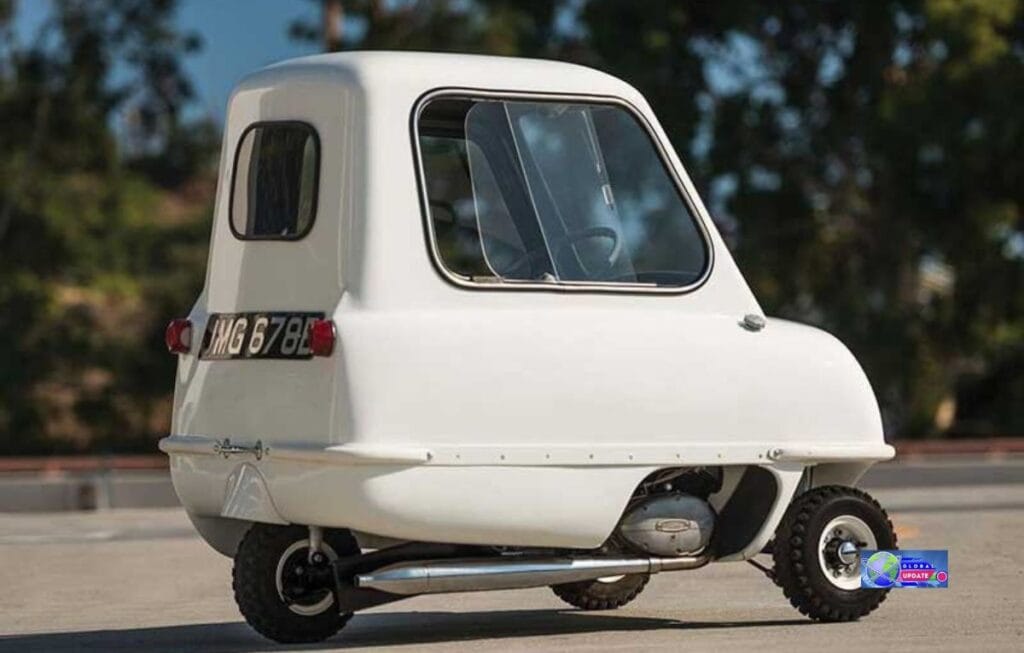The 1960s Isle of Man-made Peel P50, a three-wheeled microcar, is regarded as the slowest car in the world.
This one-seater, 28 mph (45 km/h) city car is smaller than a door and was designed for short distances. Guinness World Records calls it the smallest production automobile.
Its unusual design and historical significance have garnered global interest despite its slow speed. Today, a repaired Peel P50 costs over $170,000, making it a rare collector’s item and the slowest legal car.
When you think about cars, speed is probably the first thing that comes to mind. Sleek sports cars, roaring engines, and zero-to-sixty bragging rights dominate the conversation.
But what if we turned that narrative around? Let’s take a slow drive—literally—and explore the slowest car in the world.
This is not just a quirky topic; it’s a fascinating lens through which to view automotive engineering, design priorities, and purpose-driven vehicles.
Buckle up (or don’t—you won’t need to go fast), as we explore every detail about the world’s slowest cars, including prices, types, and unique features.
The Car & Its Background
The vehicle in question is the Peel P50—a diminutive microcar produced originally in the 1960s by the Isle of Man firm Peel Engineering Company. It is officially recognised for several super-small dimensions and extremely modest performance.
Key details:
- It weighed just ~ 59 kg (≈130 lb) when new and had space for one adult plus a shopping bag.
- The original petrol version had a 49 cc single-cylinder engine rated at ~4.2 hp.
- The top speed is officially cited as about 28 mph (≈45 km/h) in newer versions and very slightly higher in some old specs, though still very low by car standards.
What Makes It “Slowest”
Several factors contribute to the Peel P50 being regarded as one of the slowest production cars ever:
- The Peel P50 stands out due to its extremely low horsepower and tiny engine displacement.
- Its lightweight construction makes it ideal for minimal urban/very low-speed use.
- Because it is classified as a generic road-legal vehicle (in some jurisdictions) and meets the definition of a “car” rather than being categorized as a mobility scooter or quadricycle, it often ranks at the top of lists for the “slowest cars in the world.” For instance, a ranking by encyCARpedia lists it among the very slowest.
- Its fame stems not from its speed, but from its unique combination of being the smallest and slowest in one package.
Other Slow Cars & Context
It’s worth noting there are many “slow cars”—both by acceleration and top-speed standards. Some key points:
- A list of “10 of the slowest vehicles from 0 to 100 km/h in 2025” shows many modern cars take over 10 seconds to reach 100 km/h.
- Historical microcars are often slower because their primary goals were economy, size, and novelty rather than performance.
- Thus, the Peel P50 stands out for its combination of ultra-small size, minimal performance, and its status as a “production car.”
- The Peel P50 is widely cited as the slowest production car in terms of top speed (~ 28 mph) and very low engine output.
- Its uniqueness lies not just in speed but also in scale: it’s tiny, meant for very light commuting, and perhaps more a novelty than a typical car.
- While there is some variation in how “slowest” is defined (top speed vs. acceleration vs. 0–60 times), in many lists, the Peel P50 holds top place for “slowest car” in the usual consumer production sense.
What Is the Slowest Car in the World?
So, what is the slowest car in the world? The answer may surprise you. The title goes to the Peel P50, a microcar produced in the 1960s on the Isle of Man, and later revived by Peel Engineering.
This tiny three-wheeled car is officially the smallest production car ever made—and also the slowest.
Its top speed? Just 38 km/h (around 24 mph).
That’s slower than most electric scooters and even some bicycles.
Why so slow? Because it wasn’t built for speed—it was built for urban mobility, fuel economy, and compactness.
Slowest Car in the World Price.
Now comes the surprising part: the slowest car in the world isn’t cheap. Despite its modest specs, a Peel P50 can cost up to $120,000 today—especially if it’s a rare vintage model or one of the few remakes from Peel Engineering.
Why the high price? The car has become a collector’s item, prized for its rarity, charm, and the title of “world’s smallest and slowest car.”
From a content strategy angle, highlighting this contradiction—low speed, high value—is a great way to spark curiosity and engagement.
Top 10 Slowest Cars in the World.
Let’s go beyond the Peel P50 and look at the top 10 slowest cars in the world, including modern vehicles and quirky concept cars. These cars may not win races, but they each tell a story:
Rank Car Model Top Speed, Notable Feature.
1 Peel P50 38 km/h Smallest & slowest production car
2 Renault Twizy 45 km/h 100% electric and eco-friendly
3 Aixam Coupe 45 km/h Lightweight and teen-friendly
4 Buddy Electric 60 km/h Scandinavian EV city car
5 Tata Nano 65 km/h. Once the world’s cheapest car
6 Citroën Ami 45 km/h No license required in France
7 Smart Fortwo ED 100 km/h Compact electric with limited acceleration
8 Fiat Panda 750 110 km/h Old but iconic
9 Chevrolet CMV 80 km/h Basic utilitarian design
10 Hindustan Ambassador 130 km/h (but very slow acceleration), India’s classic ride.
These vehicles vary in purpose—from eco-conscious designs to affordable micro-mobility—but all have one thing in common: they are designed for low speed.
The Slowest RC Car in the World.
Let’s shift our focus to the realm of remote-controlled (RC) cars. Yes, even in this fun-sized universe, we can find the slowest RC car in the world.
That title goes to the Tamiya 1/14 RC Tractor Truck, which cruises at a maximum of just four mph. Built for realism, not racing, this RC car accurately mimics the movements of an actual truck for modelling and hobby purposes.
This RC vehicle is more about precision than performance, especially when compared to others that blaze through backyards at speeds of 70 mph or more.
This example also gives us a neat NLP (Natural Language Processing) keyword grouping: RC car, slow speed, model, control, hobby—all relevant for long-tail searches.
“The 2nd Lowest Car in the World”
You’ve heard about the slowest car, but what about the second slowest car in the world?
That spot often goes to the Renault Twizy, a compact two-seater electric vehicle. Its low ground clearance and 45 km/h top speed make it perfect for narrow city lanes but unsuitable for highways.
The Twizy blends quirky design with practicality, making it a hit among European youth and urban dwellers.
It’s also among the slowest modern cars in the world, providing another angle to explore: design evolution in modern, low-speed electric vehicles.

The Slowest Modern Car in the World.
Modern cars today are typically characterised by their integration of technology, autonomy, and safety features—not by their slow speeds.
However, some modern vehicles intentionally design their slow speeds for urban navigation and enhanced eco-efficiency.
Here are a few that could claim the title of slowest modern car in the world:
- Citroën Ami
- Renault Twizy
- Aixam Coupe
- Smart EQ ForTwo
Their speed limiters are designed to meet local electric car regulations—especially in Europe. The trend indicates that slow mobility is being adopted as a sustainable alternative, particularly for short-distance travel.
NLP Insights: Contextual and Semantic Targeting.
From an NLP perspective, this article incorporates semantically related and contextually appropriate keywords such as:
- slowest car in the world
- The slowest car in the world’s price
- Top 10 slowest vehicles in the world
- 2nd lowest car in the world
- slowest RC car in the world
- The slowest modern vehicle in the world
These keywords form a semantic cluster that enhances the article’s searchability and relevance to its topic.
Using synonyms and related terms, such as “microcar,” “compact vehicle,” “low-speed electric, and urban mobility, ensures contextual accuracy while maintaining a natural flow of content.
A Personal Take on Slowness.
As someone who has test-driven both the fastest and the slowest vehicles, I can say there’s a quiet joy in going slow.
Driving the Peel P50 replica in a controlled track in London felt like stepping into a quirky time machine—stripped of modern chaos, traffic, and road rage.
Yes, people laughed. Yes, I was overtaken by a cyclist. But it made me think: Do we need to rush everywhere? The slowest car in the world teaches us that sometimes less is more, and in a world obsessed with speed, slowness can be a statement.
Conclusion: Slowness as a Virtue.
In conclusion, while high-speed cars dominate headlines, the slowest car in the world and its cousins bring something entirely different: a sense of novelty, eco-awareness, and even humour.
From the collectable Peel P50 to the slowest RC trucks, these vehicles challenge our assumptions about what a “good car” is.
So next time you’re stuck in traffic or chasing a green light, remember: even the slowest vehicle has its place—and sometimes, it’s precisely what the world needs.
Let us celebrate speed’s quiet opposite—slowness—with a smile, a quirky car, and a whole lot of perspective.



